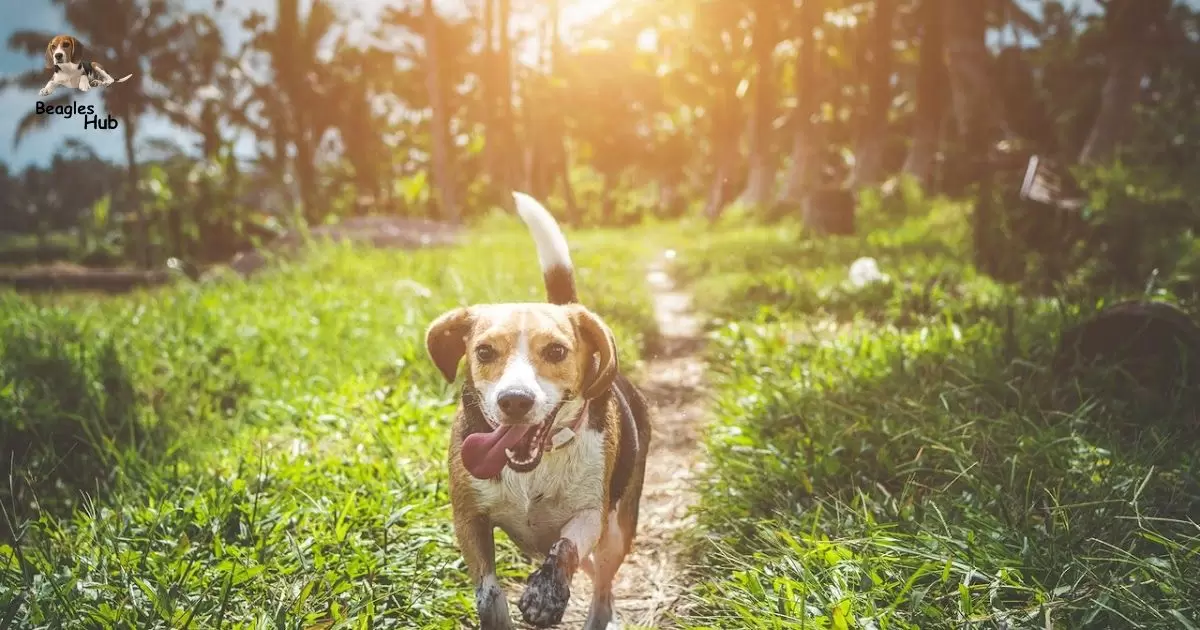Beagles are beloved family companions known for their friendly, energetic personalities and adorable floppy ears. While these curious hounds were originally bred as hunting dogs, their modern lifestyles often involve being pampered members of the household. However, many Beagle owners wonder if their furry friends can adapt to living primarily outdoors.
The truth is, Beagles are not ideally suited for a strictly outdoor lifestyle. Their small stature, short coat, and lack of an insulating undercoat make them susceptible to extreme temperatures and weather conditions. Additionally, their inquisitive nature and love of following scents can lead them into potential dangers if left unsupervised outside.
In this comprehensive guide, we’ll explore the suitability of Beagles for outdoor living, addressing various factors such as their breed history, personality traits, weather tolerance, and potential hazards. We’ll also delve into practical considerations like providing appropriate shelter, ensuring proper nutrition and exercise, and implementing preventive health measures. Join us as we navigate the world of outdoor Beagles, ensuring their comfort, safety, and overall happiness.
| Factor | Details |
|---|---|
| Breed History | Originally bred as outdoor hunting dogs, but modern Beagles are family companions |
| Personality Traits | Curious, energetic, prone to wandering and barking if unsupervised outside |
| Cold Weather Tolerance | Susceptible to cold due to small size and short coat – risk of hypothermia/frostbite |
| Hot Weather Tolerance | Can overheat easily in hot, humid conditions – risk of heatstroke |
| Recommended Temperatures | 40°F to 70°F (4°C to 21°C) is ideal for outdoor time |
| Outdoor Hazards | Escape, ingesting objects, wild animal encounters, chasing small animals, theft |
| Shelter Needs | Well-insulated, weatherproof doghouse or kennel with proper bedding |
| Supervision | Should not be left unsupervised outside for extended periods |
| Better Alternatives | Fenced yard access, doggy daycare, pet sitters, indoor/outdoor rotation |
Did Beagle Hunting Dogs Live Outside?
Beagles were originally bred as hunting dogs, and their ancestors lived and worked primarily outdoors. These energetic hounds were developed to assist hunters in tracking and pursuing small game like rabbits and hares over long distances. Their compact size, stamina, and strong sense of smell made them well-suited for this outdoor lifestyle.
However, it’s essential to note that modern-day Beagles are primarily kept as beloved family companions rather than working hunting dogs. While their ancestors may have thrived in outdoor environments, domesticated Beagles have different needs and considerations.
The Beagle’s Personality and How This Relates to Living Outside
Beagles are known for their friendly, curious, and energetic personalities. These traits, combined with their strong hunting instincts and love of sniffing and exploration, can make them challenging to manage in an unsupervised outdoor environment.
Some key personality traits to consider:
- Wanderlust: Beagles have a tendency to wander off and follow their noses, which can lead to them getting lost or into trouble if left outside unattended.
- Bark-happy: Their vocal nature means they may bark excessively when left outside, potentially disturbing neighbors.
- Diggers: Beagles love to dig, which can ruin yards and gardens if left unchecked.
- Food-motivated: Their strong food drive can lead them to scavenge for scraps or eat things they shouldn’t if left unsupervised outdoors.
While Beagles do require plenty of exercise and mental stimulation, which can be provided through outdoor playtime and walks, their personalities and instincts make it challenging to leave them outside for extended periods without proper supervision and containment.
What Weather Conditions Can a Beagle Safely Endure?
Beagles are generally hardy and adaptable dogs, but they are not designed for extreme weather conditions. Here’s a closer look at their tolerance levels:
- Cold Weather: With their short fur and small stature, Beagles are susceptible to extreme cold. Temperatures below freezing, especially with wind chill or precipitation, can put them at risk of hypothermia and frostbite. Providing proper shelter, insulation, and monitoring is essential.
- Hot Weather: Beagles can overheat in hot, humid conditions, especially if left without shade or access to water. Heat stroke is a serious risk, and they should be kept indoors during extreme heat waves.
- Rain and Snow: While their water-resistant double coat provides some protection, prolonged exposure to rain, snow, or wet conditions can lead to discomfort, matting, and potential health issues.
- Wind and Sun: Strong winds and direct sunlight can cause discomfort and increase the risk of overheating or chilling, depending on the temperature.
The ideal weather conditions for Beagles to be outside are mild temperatures (between 40°F and 70°F), partial shade, and low humidity. However, even in suitable conditions, they should have access to shelter, water, and only be left unsupervised for short periods.
Full List of Dangers if a Beagle is Outside Alone
While Beagles enjoy outdoor time, leaving them unsupervised outside for extended periods can expose them to various dangers:
- Escape: Their curious nature and love of following scents can lead them to wander off and become lost if left in an unsecured area.
- Ingestion of Dangerous Objects: Beagles are known for indiscriminate eating habits, putting them at risk of ingesting toxic substances, sharp objects, or other harmful materials.
- Wild Animal Encounters: Unsupervised Beagles may encounter larger predators like coyotes or even stray dogs, putting them at risk of injury or attack.
- Chasing Small Animals: Their strong prey drive can lead them to chase and potentially harm small animals like squirrels, cats, or even birds.
- Extreme Weather Exposure: Without proper shelter, Beagles can suffer from hypothermia, heatstroke, or other weather-related issues.
- Theft or Harassment: Unattended dogs can be targets for theft or harassment by malicious individuals.
- Traffic Hazards: If left near roads or driveways, Beagles may inadvertently wander into traffic.
- Digging and Destruction: Their natural digging tendencies can lead to extensive property damage if left unsupervised in a yard.
- Noise Complaints: Beagles are known for their distinctive bark, which can lead to noise complaints from neighbors if left outside for extended periods.
- Lack of Socialization and Bonding: Prolonged periods of isolation can lead to behavioral issues and weaken the bond between the Beagle and its owners.
To mitigate these risks, it’s crucial to provide proper supervision, secure containment (fenced yard or kennel), and only allow outdoor time in suitable weather conditions if you plan to let your Beagle spend time outside.
Understanding Beagle’s Cold Weather Tolerance
Beagles are not particularly well-suited for extreme cold weather due to their small size, short fur, and lack of an insulating undercoat. However, with proper precautions and preparation, they can tolerate moderately cold temperatures for short periods.
Here are some key factors that influence a Beagle’s cold weather tolerance:
- Age: Puppies and senior Beagles have a lower tolerance for cold temperatures and are more susceptible to hypothermia and other cold-related issues.
- Body Condition: Well-muscled, healthy Beagles with a moderate amount of body fat are better equipped to handle cold weather compared to underweight or overweight individuals.
- Coat Condition: A well-groomed, healthy coat with proper oils can provide better insulation against the cold.
- Acclimation: Beagles that are gradually introduced to cooler temperatures tend to adjust better than those suddenly exposed to extreme cold.
- Shelter: Access to a warm, insulated shelter or doghouse is crucial for maintaining body temperature and avoiding hypothermia.
- Precipitation: Rain, snow, or wet conditions can rapidly lower a Beagle’s body temperature, even in moderate cold.
- Wind Chill: Strong winds can significantly increase the risk of hypothermia and frostbite, even in temperatures that may seem manageable.
It’s essential to closely monitor your Beagle’s behavior and body temperature when exposed to cold weather and promptly bring them inside if they exhibit signs of discomfort or distress.
Signs of Cold Weather Impact on Beagles
While Beagles can tolerate moderate cold temperatures for short periods with proper precautions, prolonged exposure to extreme cold can have serious consequences. Here are some signs to watch out for that may indicate your Beagle is being negatively impacted by cold weather:
- Shivering: Uncontrollable shivering is a clear sign that your Beagle is feeling too cold and their body is trying to generate warmth.
- Lethargy: A sudden decrease in energy levels or reluctance to move could be a sign of hypothermia setting in.
- Whining or Anxiety: If your usually happy-go-lucky Beagle seems distressed or anxious, it could be due to the cold temperatures.
- Seeking Warmth: If your Beagle is constantly trying to find warm spots or burrowing into blankets, it’s a sign they’re feeling too cold.
- Pale or Blue Gums: As a Beagle’s body temperature drops, their gums may appear pale or take on a bluish tint, indicating poor circulation.
- Frostbite: Check for redness, swelling, or discoloration on exposed areas like the ears, tail, and paws, which can be signs of frostbite.
- Stiffness or Limping: Cold temperatures can exacerbate joint pain and stiffness, leading to limping or difficulty moving.
- Decreased Appetite: A Beagle’s appetite may decrease as their body conserves energy to maintain warmth.
If you notice any of these signs, it’s crucial to bring your Beagle indoors immediately and seek veterinary attention if needed. Prompt action can prevent severe cold-related conditions like hypothermia or frostbite.
Optimal Outdoor Conditions for Beagles
While Beagles can enjoy supervised outdoor time, it’s essential to ensure the conditions are suitable for their wellbeing. Here are some optimal outdoor conditions for Beagles:
- Temperature Range: Beagles are most comfortable in temperatures between 40°F and 70°F (4°C to 21°C). Extreme heat or cold can be hazardous.
- Shade Availability: Access to shaded areas is crucial to prevent overheating and provide relief from direct sunlight.
- Dry and Well-Drained Areas: Wet or muddy conditions can lead to discomfort, matting, and potential health issues.
- Secure Fencing or Enclosure: A securely fenced yard or enclosure is necessary to prevent wandering and potential escape.
- Fresh Water and Shelter: Beagles should have access to clean water and a sheltered area to escape harsh weather conditions.
- Supervision: Beagles should never be left unsupervised outdoors for extended periods due to their inquisitive nature and potential for mischief.
- Appropriate Duration: Outdoor time should be limited to reasonable periods based on weather conditions, with frequent breaks and access to indoor spaces.
- Engaging Activities: Providing toys, puzzles, or other enrichment can help keep Beagles mentally stimulated and prevent destructive behaviors.
By ensuring these optimal conditions are met, Beagles can safely enjoy outdoor playtime and exercise while minimizing the risks associated with prolonged exposure to extreme weather or unsupervised roaming.
Winter Health Concerns for Beagles
While Beagles can tolerate moderate cold weather with proper precautions, prolonged exposure to harsh winter conditions can lead to various health concerns. Here are some common winter health issues to watch out for:
- Hypothermia: Beagles are susceptible to hypothermia, a dangerous condition where their body temperature drops too low. This can lead to shivering, lethargy, and even organ failure if left untreated.
- Frostbite: Exposed areas like the ears, tail, and paws are vulnerable to frostbite, a condition where the skin and tissue freeze, causing discoloration, swelling, and potential tissue damage.
- Joint Stiffness and Arthritis: Cold temperatures can exacerbate joint pain and stiffness, making it difficult for Beagles to move comfortably.
- Dry Skin and Coat Issues: Dry winter air can lead to itchy, flaky skin and a dull, brittle coat, potentially causing discomfort and increasing the risk of skin infections.
- Cracked Paw Pads: Exposure to ice, snow, and harsh winter chemicals can cause cracking and splitting of the paw pads, leading to painful walking and potential infections.
- Dehydration: Beagles may not drink as much water in the winter, leading to dehydration and potential urinary tract issues.
- Antifreeze Poisoning: Antifreeze spills or leaks are highly toxic to dogs and can be challenging to spot in snow or ice.
To mitigate these risks, it’s crucial to limit your Beagle’s outdoor time during extreme winter weather, provide proper shelter and insulation, and closely monitor their behavior and physical condition. Regular grooming, moisturizing, and paw protection can also help protect against winter-related health issues.
Indoor Comfort for Beagles in Winter
While Beagles can tolerate short periods outdoors in moderate winter weather, ensuring their indoor comfort and safety during the colder months is essential. Here are some tips for keeping your Beagle cozy and content indoors:
- Temperature Control: Maintain a comfortable indoor temperature between 65°F and 75°F (18°C to 24°C). Consider using a space heater or insulating drafty areas if necessary.
- Cozy Bedding: Provide a warm, soft, and insulated bed or crate area for your Beagle to rest comfortably. Consider adding extra blankets or a heated pet bed.
- Humidity Levels: Dry winter air can lead to skin and respiratory issues. Use a humidifier to maintain optimal humidity levels between 30% and 50%.
- Mental Stimulation: Provide plenty of interactive toys, puzzles, and playtime to keep your Beagle entertained and mentally stimulated during indoor time.
- Indoor Exercise: Set up indoor obstacle courses, play fetch in a hallway, or invest in a treadmill or exercise wheel to help your Beagle burn off energy.
- Grooming Routine: Regular brushing and moisturizing can help maintain a healthy coat and prevent excessive shedding during the dry winter months.
- Hydration: Ensure your Beagle has access to fresh, clean water at all times and encourage drinking to prevent dehydration.
- Socialization: Spend quality time with your Beagle and consider doggy daycare or playdates to provide essential socialization and companionship.
By creating a comfortable, enriching, and safe indoor environment, you can help your Beagle thrive during the winter months and avoid potential health risks associated with prolonged outdoor exposure.
Nutritional Needs in Cold Weather
Beagles may require some adjustments to their diet and nutrition during cold weather to maintain their energy levels, body condition, and overall health. Here are some key nutritional considerations:
- Increased Caloric Intake: Beagles expend more energy trying to regulate their body temperature in cold weather, so they may need a slightly higher caloric intake to compensate.
- Fatty Acid Supplementation: Omega-3 and omega-6 fatty acids can help support a healthy skin and coat, which is essential for insulation during the winter months.
- Protein Intake: Adequate protein is crucial for maintaining muscle mass and supporting the immune system during cold weather.
- Hydration: Ensure your Beagle has access to fresh, clean water at all times, as dehydration can be a concern in dry winter conditions.
- Digestive Support: Cold weather can sometimes lead to digestive issues or changes in appetite. Consider adding probiotics or digestive enzymes to support gut health.
- Joint Supplements: Glucosamine and chondroitin supplements can help support joint health and mobility, which is particularly important for senior Beagles or those with arthritis during the cold months.
It’s always best to consult with your veterinarian to determine the appropriate dietary adjustments for your Beagle based on their age, activity level, and overall health. Making gradual changes and monitoring your Beagle’s body condition can help ensure they maintain optimal health and energy during the winter season.
Winter Exercise for Beagles
While it’s important to limit outdoor time during extreme winter weather, Beagles still need regular exercise to maintain their physical and mental well-being. Here are some tips for safe and enjoyable winter exercise for your Beagle:
- Indoor Activities: Set up indoor obstacle courses, play fetch in a hallway or basement, or invest in a treadmill or exercise wheel to keep your Beagle active without braving the elements.
- Short Outdoor Walks: When temperatures are moderate and conditions are dry, take your Beagle for short, brisk walks to burn off energy and enjoy some fresh air.
- Indoor Dog Parks or Daycare: Consider taking your Beagle to an indoor dog park or doggy daycare facility, where they can safely play and socialize with other dogs.
- Winter Sports: If you live in an area with consistent snow cover, consider activities like skijoring (being pulled on skis by your dog) or mushing (dog sledding) for a fun and invigorating winter workout.
- Mental Enrichment: Provide interactive toys, puzzles, and training sessions to keep your Beagle’s mind engaged and stimulated during indoor time.
- Warm-up and Cool-down: Always allow your Beagle to warm up and cool down gradually before and after strenuous exercise to avoid injury or discomfort.
Grooming and Skin Care for Beagles in Winter
Proper grooming and skin care are essential for keeping your Beagle healthy and comfortable during the dry, cold winter months. Here are some tips to help maintain their coat and skin:
- Regular Brushing: Brush your Beagle’s coat at least once a week to remove loose hair, prevent matting, and distribute natural oils throughout their fur.
- Moisturizing Baths: Use a mild, moisturizing shampoo and conditioner formulated for dogs to help combat dry, itchy skin. Avoid over-bathing, as it can strip away essential oils.
- Leave-in Conditioners: Apply a leave-in conditioner or coat spray after bathing to help lock in moisture and protect against static electricity.
- Humidifiers: Run a humidifier in your home to add moisture to the dry winter air, which can help prevent skin irritation and excessive shedding.
- Paw Protection: Apply a paw wax or balm to your Beagle’s paw pads to prevent cracking and drying from the cold, snow, and ice.
- Nose Balm: Use a nose balm or butter to protect your Beagle’s nose leather from becoming dry, cracked, and uncomfortable in the winter air.
- Fatty Acid Supplements: Supplement your Beagle’s diet with omega-3 and omega-6 fatty acids to support a healthy skin and coat from the inside out.
- Regular Vet Checks: Schedule regular visits with your veterinarian to catch and address any skin or coat issues early on.
By maintaining a consistent grooming routine and taking preventive measures, you can help your Beagle stay comfortable, healthy, and looking their best throughout the winter season.
Clothing and Accessories for Beagles in Cold Weather
While Beagles have a natural coat of fur, they may benefit from additional protection and insulation during particularly cold or harsh winter conditions. Here are some clothing and accessory options to consider:
- Coats or Jackets: Invest in a well-fitting dog coat or jacket made of insulating materials like fleece or down to help retain body heat during outdoor activities.
- Sweaters: Lightweight, breathable sweaters can provide an extra layer of warmth without restricting movement.
- Booties or Paw Wax: Dog booties or paw wax can protect your Beagle’s sensitive paw pads from the cold, snow, ice, and harsh winter chemicals.
- Ear Covers or Muffs: For dogs with naturally floppy ears, ear covers or muffs can help prevent frostbite and keep their ears warm.
- Reflective Gear: Reflective vests, collars, or leashes can increase visibility and safety during low-light winter conditions.
- Heated Beds or Pads: Provide your Beagle with a cozy, heated bed or pad to snuggle up on during indoor rest periods.
- Insulated Kennels or Doghouses: If your Beagle spends any time outdoors, an insulated kennel or doghouse with proper bedding can provide vital shelter from the elements.
When selecting clothing or accessories, ensure they fit properly and do not restrict movement, breathing, or natural behaviors. Introduce new items gradually and supervise your Beagle to ensure they are comfortable and safe. Always remove any clothing or accessories when indoors to prevent overheating.
Beagle’s Behavioural Changes in Winter
Just like humans, Beagles may experience some behavioral changes during the colder winter months. Understanding these potential shifts can help you better support your furry friend:
- Increased Sleep and Lethargy: Beagles may sleep more and appear lazier during the winter due to the lower temperatures and shorter daylight hours.
- Decreased Appetite: Some Beagles may have a reduced appetite in the winter, as their bodies don’t need as many calories to maintain their energy levels.
- Cabin Fever: With limited opportunities for outdoor exercise and exploration, Beagles may become restless, destructive, or develop behavioral issues from boredom and pent-up energy.
- Separation Anxiety: Beagles may experience increased separation anxiety or clinginess due to spending more time indoors with their owners.
- Grooming Challenges: Excessive shedding or dry, itchy skin may lead to increased grooming needs and potential skin irritations.
- Potty Training Regression: The cold weather and shorter daylight hours can sometimes cause potty training setbacks, as Beagles may be reluctant to go outside.
By being aware of these potential behavioral changes, you can take proactive measures to address them. Provide plenty of indoor enrichment activities, maintain consistent routines, and consider adjusting your Beagle’s diet or grooming regimen as needed. Regular exercise, playtime, and quality time with your furry friend can also help mitigate any negative behavioral impacts.
Preventive Health Measures for Beagles in Winter
Ensuring your Beagle’s overall health and well-being during the winter months is essential for their comfort and safety. Here are some preventive health measures to consider:
- Vaccinations and Parasite Prevention: Keep your Beagle up-to-date on all necessary vaccinations, flea, tick, and heartworm prevention to maintain their immune system and protect against potential winter-related health risks.
- Winterize Your Home: Inspect your home for drafts, seal any cracks or openings, and ensure your Beagle’s indoor living space is well-insulated and free from potential hazards like antifreeze or rock salt.
- Winter Safety Gear: Invest in reflective gear, booties, and other accessories to keep your Beagle visible and protected during outdoor adventures.
- Emergency Supplies: Have a pet emergency kit on hand with essentials like blankets, extra food and water, and first-aid supplies in case of power outages or severe weather events.
- Regular Vet Checks: Schedule regular wellness visits with your veterinarian to catch and address any potential health issues early on.
- Identification and Microchipping: Ensure your Beagle is properly identified with a collar, tags, and microchip in case they become lost or separated during the winter months.
- Winterize Your Vehicle: If you frequently travel with your Beagle, ensure your vehicle is winterized and equipped with safety gear, such as a pet carrier or crate, in case of emergencies or inclement weather.
By taking these preventive measures, you can help safeguard your Beagle’s health and well-being throughout the winter season, reducing the risk of potential issues and ensuring they remain comfortable and happy.
Can Beagles Sleep Outside?
While Beagles were originally bred as outdoor hunting dogs, their ability to comfortably sleep outside in modern times depends on various factors, including weather conditions, shelter, and individual tolerance levels.
In general, it’s not recommended to leave Beagles outside overnight or for extended periods, especially in extreme cold, heat, or inclement weather. However, with proper precautions and accommodations, some Beagles may be able to sleep outside for short periods in mild to moderate temperatures.
Here are some key considerations regarding Beagles sleeping outside:
- Weather Conditions: Beagles are susceptible to both extreme cold and heat. Temperatures below freezing or above 80°F (27°C) can put them at risk of hypothermia or heatstroke, respectively.
- Shelter and Insulation: If sleeping outside, Beagles must have access to a well-insulated, weatherproof doghouse or kennel with adequate bedding material, such as straw or blankets, to retain body heat.
- Age and Health: Puppies, senior Beagles, and those with pre-existing health conditions are less tolerant of outdoor sleeping and should be kept indoors.
- Acclimation: Beagles that have been gradually acclimated to outdoor conditions may be better suited for occasional outdoor sleeping than those accustomed to strictly indoor living.
- Supervision: Even with proper shelter, Beagles should never be left unsupervised when sleeping outside, as they can dig out, escape, or encounter potential hazards.
- Individual Tolerance: Some Beagles may naturally tolerate outdoor sleeping better than others, but close monitoring is essential to ensure their safety and comfort.
If you do choose to allow your Beagle to sleep outside, it’s crucial to provide a secure, well-insulated shelter, monitor the weather conditions closely, and ensure they have access to fresh water and the ability to go inside if they become uncomfortable or distressed.
Better Alternatives Than Having a Beagle Live Outside
While Beagles can enjoy supervised outdoor time and playtime, keeping them as strictly outdoor dogs is generally not recommended due to their companionship needs and potential safety risks. Here are some better alternatives to consider:
- Indoor Living with Outdoor Access: Provide your Beagle with a secure, fenced yard or exercise area where they can spend supervised outdoor time while still enjoying the comforts and safety of an indoor living space.
- Doggy Daycare or Dog Walker: If you’re away from home for extended periods, consider enrolling your Beagle in a reputable doggy daycare or hiring a professional dog walker to ensure they receive adequate exercise, socialization, and indoor relief.
- Rotating Indoor/Outdoor Time: Implement a schedule where your Beagle spends some time indoors and some time outdoors, rotating as necessary to accommodate their needs and your availability for supervision.
- Indoor Enrichment: Provide plenty of interactive toys, puzzles, and training sessions to keep your Beagle mentally stimulated and engaged when indoors.
- Climate-Controlled Dog Room or Kennel: If outdoor access is essential, consider creating a climate-controlled indoor dog room or kennel area that provides a safe, comfortable space for your Beagle when you’re away.
- Hiring a Pet Sitter: When away for extended periods, hire a professional pet sitter to stay at your home and provide your Beagle with the necessary care, supervision, and companionship.
By exploring these alternatives, you can ensure your Beagle’s safety, comfort, and overall well-being while still accommodating their need for exercise, mental stimulation, and socialization.
Conclusion
While Beagles may have ancestors that were bred for outdoor hunting, their modern-day counterparts require careful consideration and accommodations to ensure their safety and comfort in outdoor living environments. Through this comprehensive guide, it’s clear that Beagles are not ideally suited for a strictly outdoor lifestyle due to their physical characteristics and breed tendencies.
However, with proper precautions and provisions, supervised outdoor time and even occasional overnight outdoor sleeping can be manageable for Beagles in mild weather conditions. The key lies in understanding their unique needs, providing adequate shelter, monitoring weather extremes, addressing potential hazards, and prioritizing their overall well-being through appropriate nutrition, exercise, grooming, and preventive healthcare measures.
Ultimately, the decision to incorporate outdoor living for your Beagle should be based on a careful evaluation of their individual circumstances, age, health, and personal tolerance levels. By exploring alternative arrangements, such as indoor living with outdoor access or hiring professional pet care services, you can ensure your furry friend’s safety, comfort, and companionship needs are met. Remember, every Beagle is an individual, and their happiness should always be the top priority when considering their living arrangements.
Frequently Asked Questions
Can Beagles live outdoors year-round?
While Beagles can tolerate short periods outdoors in mild weather, it’s generally not recommended to keep them as strictly outdoor dogs year-round. They require access to indoor shelter, especially during extreme temperatures or inclement weather.
How cold is too cold for a Beagle?
Beagles are susceptible to hypothermia and frostbite in temperatures below freezing, particularly with wind chill or precipitation. It’s best to limit outdoor time and provide proper shelter when temperatures dip below 32°F (0°C).
Do Beagles need a doghouse or kennel if they spend time outdoors?
Yes, a well-insulated, weatherproof doghouse or kennel is essential for Beagles spending time outdoors, especially during colder months. It should provide adequate space, bedding material, and protection from the elements.
Can Beagles tolerate hot weather?
Beagles are also sensitive to extreme heat and humidity, which can lead to heatstroke or other heat-related issues. It’s crucial to provide shade, access to cool water, and limit outdoor time during hot weather.
Do Beagles need special grooming or skincare in the winter?
Yes, regular brushing, moisturizing baths, and paw protection can help maintain a healthy coat and prevent dry, cracked skin or paw pads during the dry winter months.
Can I leave my Beagle outside while I’m at work?
It’s generally not recommended to leave Beagles unsupervised outdoors for extended periods, as they may become bored, destructive, or encounter potential hazards. Consider hiring a pet sitter, enrolling in doggy daycare, or providing indoor accommodations.
Are there any health concerns specific to Beagles in cold weather?
In addition to hypothermia and frostbite, Beagles may be more prone to joint stiffness, dry skin, and respiratory issues during the winter months. Regular vet check-ups and preventive measures can help address these potential concerns.







